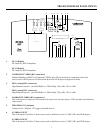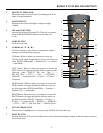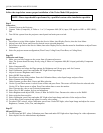
11
QUICK CONNECTION AND SETUP GUIDE
While there are many different ways to connect your source equipment to your Vidikron Projector, the examples below are the most
common.
ANALOG INPUTS:
• Composite Video Input
Composite video is the most common type of signal used, but is also the lowest in picture quality. Many sources have outputs that are
limited to composite video, such as some VCR’s and camcorders; others such as Laser Disc players actually produce slightly better
results when using composite video.
• S-Video Input
S-Video is the second-best type of signal that can be used, but is MUCH better than composite video. Using such sources as Satellite
receivers, high-quality VCRs and DVD players (with no component output) will produce a MUCH cleaner and sharper signal.
• Component Input
Component video is the best type of signal that can be used. The most common sources that use component outputs are DVD players,
and it is highly recommended that component be used when possible. Component video goes one step beyond S-Video in picture quality;
chroma (color) information is more resolved and the overall picture appears more well-dened. (be sure to shut off progressive scan on
your DVD player)
• HD1 / HD2
These are High Denition Analog inputs to connect the outputs of high denition sources such as HD tuners and set top boxes, HD
satellite receivers, etc. These inputs will accept signals as RGB, RGBHV or Component Video (YPrPb).
DIGITAL INPUTS:
• DVI 1 / DVI 2
These are High Denition Digital inputs. Vidikron recommends using these digital inputs whenever possible. Using the DVI 1 and DVI
2 inputs ensures the highest video quality because the signal is carried in the digital domain throughout the entire signal path, from
source component output into the projector. This maintains maximum signal purity.
Use these inputs to connect Digital High Denition sources that have a DVI output, such as HD tuners and set top boxes, satellite
receivers, DVD players, etc.
ISF Calibration
The Vision Model 100 has been designed to incorporate setup and calibration standards established by the Imaging Science Foundation
(ISF). The ISF has developed carefully crafted, industry-recognized standards for optimal video performance and has implemented
a training program for technicians and installers to use these standards to obtain optimal picture quality from Vidikron video display
devices. Accordingly, we recommend that setup and calibration be performed by an ISF certied installation technician.
All signal types require separate processing. Therefore there is a need to calibrate each and every input separately.
When beginning calibration, it is imperative that at least one of the analog SD inputs (Composite, S-Video, RCA Component) be
calibrated rst. In doing this, the projector is calibrated to the controller. After one of the SD inputs is calibrated, calibration of the HD
analog or DVI sections can follow.
Once the initial settings have been completed, the “front panel display” (color, tint, sharpness, etc.) can be adjusted for each aspect ratio.
The calibration procedures for these adjustments are outlined in “picture quality adjustments”.


















